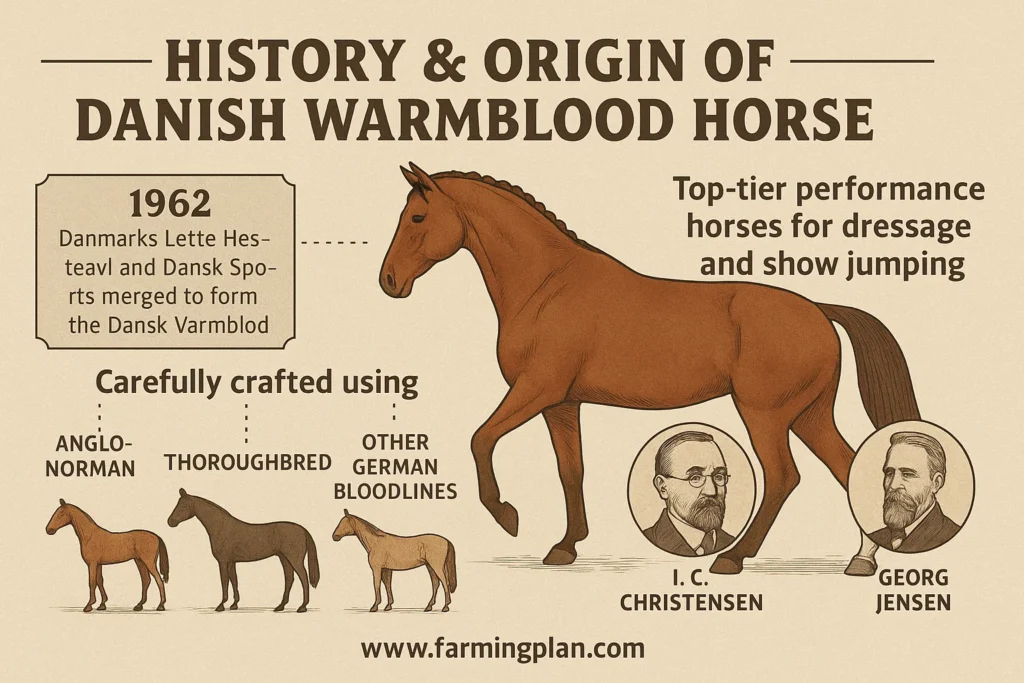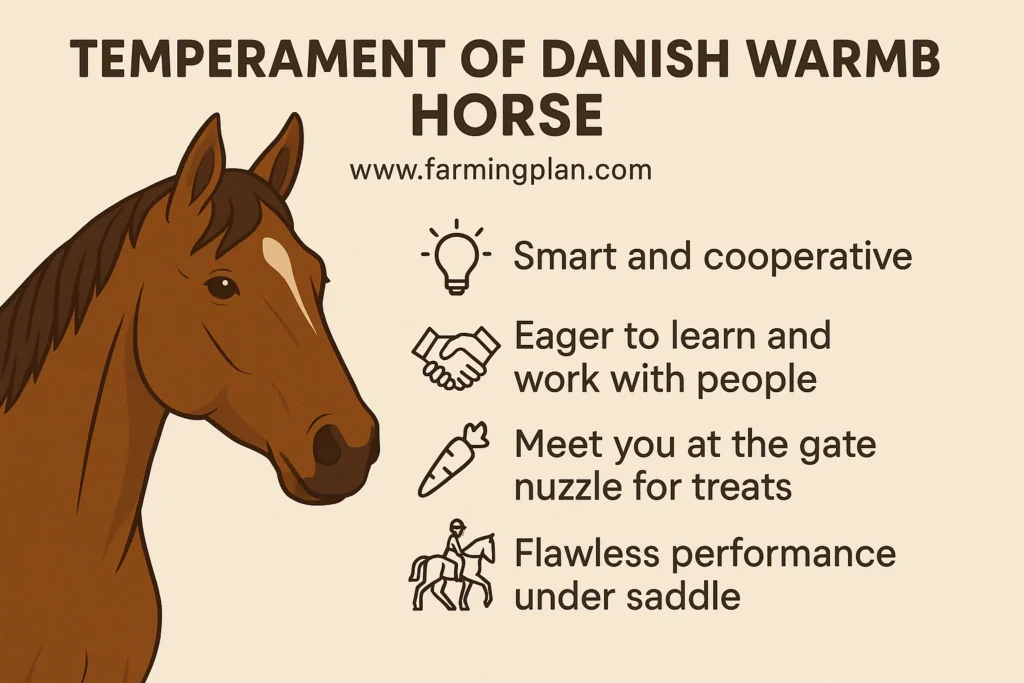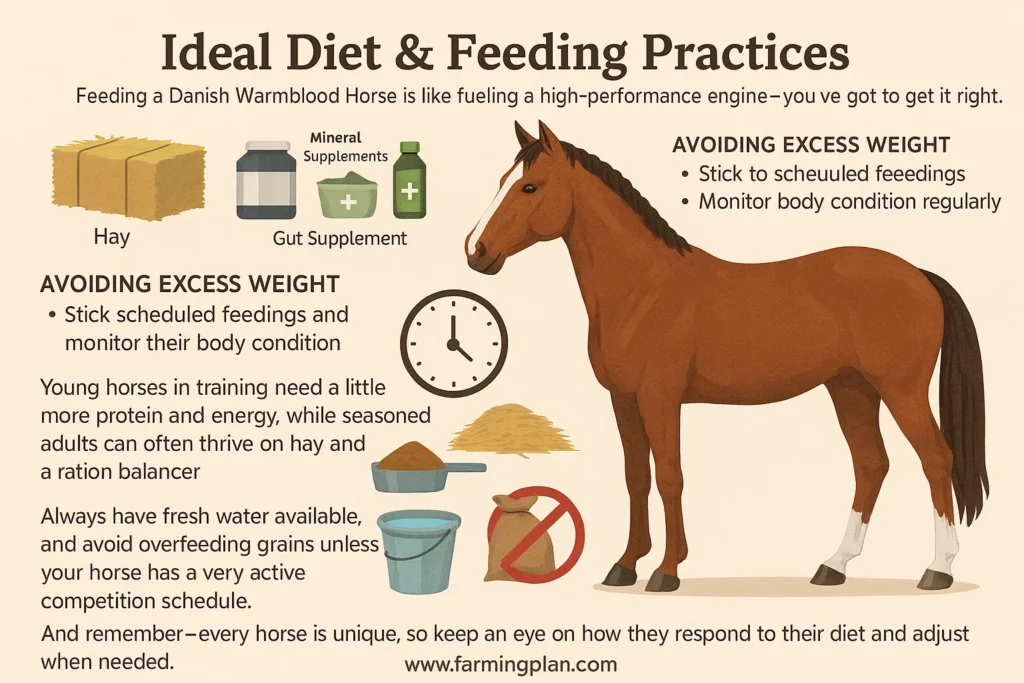If you’re anything like me and have a soft spot for graceful, intelligent horses, you will fall in love with the Danish Warmblood Horse. This breed is the real deal—stylish, innovative, and built for performance. I’ve worked with a handful over the years, and every single one impressed me with its willingness to work and refined presence in the ring. Bred primarily for dressage and show jumping, Danish Warmblood Horse are among the top European warmblood horses. Whether you’re looking for a reliable competition partner or a beautiful horse to enjoy in the paddock, this breed checks all the boxes. So, let’s dive into what makes these horses stand out in the world of sport and beyond.

History & Origin of Danish Warmblood Horse
The Danish Warmblood Horse wasn’t just plucked out of thin air—it resulted from decades of intentional breeding and serious horse-savvy effort. In 1962, two major breed societies—Danmarks Lette Hesteavl and Dansk Sports-—merged to form the Dansk Varmblod, which now oversees the breed’s development. These horses were carefully crafted using Anglo-Norman horses, Thoroughbreds, and other German bloodlines, making them a unique blend of elegance and strength.

The goal was simple: to create top-tier, non-racing performance horses for dressage and show jumping. Denmark wanted a breed that could compete with the best of the best in Europe, and boy, did they succeed. Influential figures like I. C. Christensen and Georg Jensen were deeply involved in the early breeding programs, helping establish standards that still guide Danish breeders today. And trust me, those historic roots still show in every smooth canter stride and poised jump.
Characteristics of the Danish Warmblood Horse
Let me tell you—when you see a Danish Warmblood Horse walk into the arena, you know it’s something special. They usually stand tall, with 16 to 17.2 hands, and have a strong build that says “power” but a movement that whispers “grace.” Most come in solid colors, like dark brown, bay, or chestnut, and their overall appearance is balanced and refined. It’s no wonder they often steal the spotlight in international competitions.
What makes them even more impressive is how they’re selected. Breeding focuses on athleticism, movement, and conformation. There’s a whole process involving grading mares, evaluations at 2 years, 4 years, and 5 years, and even 1-judge mare grading for approvals into the mare stud book. Breeders aren’t just tossing the dice—they’re building the next generation of competition horses, with each step backed by decades of knowledge and careful planning.
Read more: Versatile Riding Horse: The Ultimate Guide to Powerful Performance
Temperament of Danish Warmblood Horse
If you’re worried about handling a big, powerful horse—don’t be. Danish Warmblood Horse are incredibly smart and cooperative. I’ve worked with everything from rowdy foals to seasoned dressage veterans, and time after time, these horses show just how eager they are to learn and work with people. Their temperament is what makes them such stars in the dressage discipline.

These horses meet you at the gate, nuzzle your pocket for treats, and then turn around and give you a flawless performance under saddle. They’re not just intelligent horses—they’re emotionally in tune. This makes them perfect for both professional riders and ambitious amateurs. Whether you’re looking for a gentle 5-year-old dressage horse or a young mare with plenty of sparks, Danish Warmblood Horse offer something for every rider level.
Ideal Diet & Feeding Practices
Feeding a Danish Warmblood Horse is like fueling a high-performance engine—you’ve got to get it right. These horses thrive on a balanced mix of essential nutrients, fiber, and quality forage. My go-to plan includes hay with added mineral supplements, fat supplements, and a comprehensive gut supplement to keep their digestion humming along.

Avoiding excess weight, especially in horses bred for agility and endurance, is super important. Stick to scheduled feedings and monitor their body condition regularly. Young horses in training need a little more protein and energy, while seasoned adults can often thrive on hay and a ration balancer. Always have fresh water available, and avoid overfeeding grains unless your horse has a very active competition schedule. And remember—every horse is unique, so keep an eye on how they respond to their diet and adjust when needed.
How Danish Warmbloods Are Used
These horses aren’t just pretty faces—they’re workhorses in the arena. Most are bred for dressage, but they’re also rock stars in show jumping and eventing. If you’ve ever watched European equestrian events, chances are you’ve seen a Danish Warmblood Horse dominate the scoreboard. Their natural cadence, elegant movement, and responsive nature make them favorites among professional riders.
In my experience, Danish Warmblood Horse are ideal competition horses but also a joy for casual riding. Some of my students have bought Danish warmblood horses for sale in the UK and the U.S., and they’ve turned into dependable partners both in and out of the ring. With the proper training, these horses can excel in nearly any sport or horse discipline. That versatility is one of the biggest reasons they’re so popular in Danish horse breeds and European sport horse circles.
Special Traits That Set Them Apart
Here’s where the Danish Warmblood Horse stands out—they’ve got the brains and beauty. These horses have a natural flair for movement, balance, and obedience thanks to specialized breeding and distinct breeding directions. I’ve seen graceful gold medal mares perform tests resembling choreographed dances, and I still get goosebumps watching them. Another fun fact: they often win gold- and silver medals in grading evaluations, proving their quality and consistency. Plus, breeders focus on health, temperament, and longevity. The breed society even supports breeding approval and ongoing breeding evaluations, so you know what you’re getting—whether you’re looking for a top jumper or an elegant dressage star. These aren’t just good horses—they’re built to be the best.
Read more: Swedish Warmblood Horse: The Surprising Advantages You Didn’t Know About
Health Concerns & Preventative Care
Like any high-performance athlete, Danish Warmblood Horse have some health considerations. One concern I always flag is fragile foal syndrome—something responsible breeders test for. Monitoring joint health, digestion, and body weight is also key. That’s where smart nutrition and regular vet care come in. I recommend annual dental exams, vaccinations, deworming, and joint support via joint supplements. Watch out for symptoms like uneven gait, fatigue, or stiffness—they can point to deeper issues. These horses are hardy, but only if you treat them like the elite athletes they are. Prevention is always easier (and cheaper) than cure, especially with warm-blood sport horses.
Step-by-Step Danish Warmblood Horse Care Guide
Caring for a Danish Warmblood Horse takes more than love—it takes structure, knowledge, and a daily rhythm. Here’s my step-by-step guide built on years of hands-on experience to help you raise a healthy, happy, and high-performing warmblood.
Step 1: Build a Safe, Spacious, and Comfortable Environment
When it comes to Danish Warmblood Horse, space is non-negotiable. These horses are tall, powerful, and active, so they need room to move mentally and physically. I always start with a minimum of 1.5 to 2 acres per horse. That gives them enough pasture to graze, stretch, and roam naturally. Fencing matters more than people realize. Choose strong wooden post-and-rail or high-tensile wire fencing. Avoid flimsy electric tape unless it’s reinforced. A curious Danish Warmblood Horse can easily break through weak barriers.
I prefer 12×12-foot stalls inside the barn, but if it can go bigger, even better. Rubber mat flooring helps cushion their joints and reduce wear. I also keep barns well-ventilated year-round. It’s critical for respiratory health, especially during warmer months or when stabled overnight. Don’t forget rotational turnout. I rotate fields to avoid mud and overgrazing and always include dry lots or sacrifice paddocks during rainy seasons. Also, split your pasture into zones—one for feeding, another for lounging, and a shaded area for rest. These thoughtful setups can prevent hoof issues, injuries, and behavioral problems.
Step 2: Design a Tailored Feeding and Nutritional Program
Feeding a Danish Warmblood Horse is all about balance. These horses are naturally athletic but also prone to weight fluctuations if you’re not careful. My basic feeding setup starts with free-choDon’tigh-quality hay, usually a mix of orchard grass and timothy. I mix in alfalfa for more demanding workloads to provide extra protein and calcium. Grain isn’t always necessary, but I recommend low-starch, high-fat commercial feeds if your horse is incompletely trained. Add fat supplements (like rice bran or flaxseed oil) for energy without the sugar spikes.
Now, here’s a key tip: supplement them. They’re our best friend. I use:
- A comprehensive gut supplement to support digestion
- A joint supplement to protect movement and prevent strain
- A mineral and vitamin blend to make up for local soil deficiencies
Water is often oyou’reked, but I check tanks and buckets twice daily—they should always be clean and complete. I also keep salt blocks in each stall and turnout pa” dock, especially during hot weather or after intense training. To avoid colic or ulcers, introduce any dietary changes gradually” over 7–10 days. Feed 2–3 small meals per day instead of one large dump. That keeps their digestive system happy and their energy levels stable.
Step 3: Consistent grooming and health Routine
Grooming is your horse’s daily check-up. Every morning, I grab a curry comb and start at the shoulders—loosening dirt and hair while boosting circulation. Then, I move to a stiff brush to flick away debris and finish with a soft brush for that glossy finish. Hoof care is critical. I pick out hooves daily, check for thrush, abscesses, or cracks, and make sure their shoes (if they wear them) are secure. I work closely with my farrier every 6–8 weeks, depending on hoof growth and weather conditions.
Routine vet care includes:
- Deworming every 8–12 weeks or as needed based on fecal exams
- Annual vaccinations (West Nile, Tetanus, Flu/Rhino, and Rabies)
- Dental floating at least once per year to prevent chewing and behavioral issues
Danish Warmblood Horse are generally tough, but seasonal changes can’t matter.” In summer, I apply fly spray and masks daily. In winter, I use blankets based on their coat and temperature and ensure their stall bedding is dry and deep for warmth.
Step 4: Train with Patience, Structure, and Purpose
Danish Warmblood Horse shine under the saddle—but only when trained right. I started the groundwork at age 2, teaching basic commands like “walk,” “whoa,” and “back up” using a halter and lead rope. I lunge them for 10–15 minutes to builyou’vention and movement cues. By the time they’re 3 or 4, I begin light riding—usually walking and trotting under saddle. I always build a strong fouEurope’s with:
- Rhythm and temEurope’sol
- Proper bending and flexion
- Clear, consistent aids
This breed is intelligent and sensitive. They don’t respond well to force or frustration. Instead, I use positive reinforcement—a soft word, a scratch, or even a cookie when appropriate. Progress builds confidence. Whether dressage, jumping, or eventing, I create a structured weekly plan—with plenty of rest days—and track their responses. Over time, their natural elegance and work ethic begin to show.
Step 5: Monitor Behavior and Adjust As Needed
Even if everything looks perfect, your horse’s behavior will tell you what’s going on. I make it a habit to observe my horses daily, watching for changes in:
- Appetite or water intake
- Attitude under saddle
- Energy levels in turnout
- Interaction with other horses
If a horse becomes cranky or sluggish, I check its feet, teeth, saddle fit, and feeding schedule. Sometimes, it’s just boredom—Danish Warmbloods are intelligent and curious, so enrichment helps. I rotate stable toys, offer hay nets, or change training exercises to keep their minds engaged. Flexibility is key. A rigid routine doesn’t work for every horse. Stay open to adjusting feed, turnout time, or grooming techniques based on your horse’s needs. Like I always say, “The best horse care plan is the one that evolves with your horse.”
A well-bred Danish Warmblood isn’t just a horse—it’s a partner in excellence on and off the arena.
Expert Tips & Best Practices
- “Always evaluate your mare with a licensed breeding advisor before committing to any breeding program.”
- Stick with breeders that follow decades of breeding plans and breeding program guidelines.
- Join a horse society or network with other Danish breeders to stay in the loop.
- Track your horse’s bloodlines using an online database to avoid fragile matches.
- Monitor young 2-year-old mares closely; growth spurts can mask joint strain.
Read more: Trakehner Horse: Why They’re Not Just Another Breed Discover the Unmatched Elegance and Athleticism
FAQ
What is the average Danish warmblood horse price?
Prices typically range from $15,000 to $50,000, depending on age, training, and pedigree.
Are Danish Warmbloods suitable for beginners?
Absolutely! Their calm nature and trainability make them an excellent match for dedicated beginners.
How tall do Danish Warmbloods get?
Most stand between 16 and 17.2 hands, making them tall but manageable.
Where can I buy a Danish Warmblood horse for sale in the UK?
You can find them through UK-based Danish breeders, sport horse societies, or equine marketplaces.
Do Danish Warmbloods need exceptional food?
While not “special,” they thrive on a carefully balanced diet with appropriate supplements and forage.
Conclusion
The unique feature of the Danish Warmblood Horse depends on combining grace, wisdom, and action in a single package. Thanks to their background in careful breeding and stunning results in dressage and show-jumping, these horses provide dependability, beauty, and a lot of versatility. You can have a fulfilling experience raising a Danish Warmblood, whether you’ve been riding for years or are just beginning. Taking care of yourself and training your horse properly will make you help a partner and promote Europe’s legacy with one of Europe’s favored sports.
